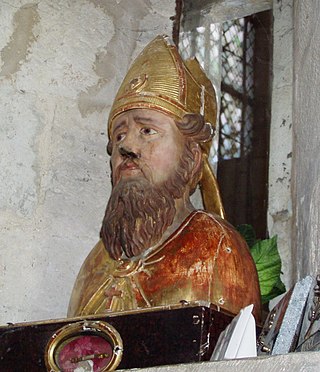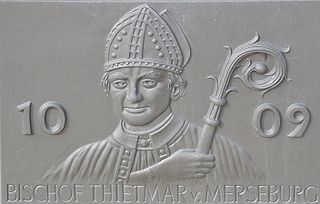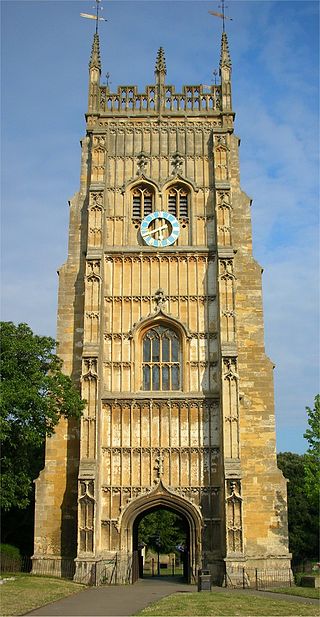Related Research Articles

Ninian is a Christian saint, first mentioned in the 8th century as being an early missionary among the Pictish peoples of what is now Scotland. For this reason he is known as the Apostle to the Southern Picts, and there are numerous dedications to him in those parts of Scotland with a Pictish heritage, throughout the Scottish Lowlands, and in parts of Northern England with a Northumbrian heritage. He is also known as Ringan in Scotland, and as Trynnian in Northern England.

Regino of Prüm or of Prum was a Benedictine monk, who served as abbot of Prüm (892–99) and later of Saint Martin's at Trier, and chronicler, whose Chronicon is an important source for late Carolingian history.

Eadmer or Edmer was an English historian, theologian, and ecclesiastic. He is known for being a contemporary biographer of his archbishop and companion, Saint Anselm, in his Vita Anselmi, and for his Historia novorum in Anglia, which presents the public face of Anselm. Eadmer's history is written to support the primacy of Canterbury over York, a central concern for Anselm.

Whithorn, is a royal burgh in the historic county of Wigtownshire in Dumfries and Galloway, Scotland, about 10 miles south of Wigtown. The town was the location of the first recorded Christian church in Scotland, Candida Casa "White/Shining House", built by Saint Ninian about 397 CE.
The Bishop of Galloway, also called the Bishop of Whithorn, is the ecclesiastical head of the Diocese of Galloway, said to have been founded by Saint Ninian in the mid-5th century. The subsequent Anglo-Saxon bishopric was founded in the late 7th century or early 8th century, and the first known bishop was one Pehthelm, "shield of the Picts". According to Anglo-Saxon ecclesiastical tradition, the bishopric was founded by Saint Ninian, a later corruption of the British name Uinniau or Irish Finian; although there is no contemporary evidence, it is quite likely that there had been a British or Hiberno-British bishopric before the Anglo-Saxon takeover. After Heathored, no bishop is known until the apparent resurrection of the diocese in the reign of King Fergus of Galloway. The bishops remained, uniquely for Scottish bishops, the suffragans of the Archbishop of York until 1359 when the pope released the bishopric from requiring metropolitan assent. James I formalised the admission of the diocese into the Scottish church on 26 August 1430 and just as all Scottish sees, Whithorn was to be accountable directly to the pope. The diocese was placed under the metropolitan jurisdiction of St Andrews on 17 August 1472 and then moved to the province of Glasgow on 9 January 1492. The diocese disappeared during the Scottish Reformation, but was recreated by the Catholic Church in 1878 with its cathedra at Dumfries, although it is now based at Ayr.

SulpitiusII. the Pious was a 7th-century bishop of Bourges and saint.

Thietmar, Prince-Bishop of Merseburg from 1009 until his death in 1018, was an important chronicler recording the reigns of German kings and Holy Roman Emperors of the Ottonian (Saxon) dynasty. Two of Thietmar's great-grandfathers, both referred to as Liuthar, were the Saxon nobles Lothar II, Count of Stade, and Lothar I, Count of Walbeck. They were both killed fighting the Slavs at the Battle of Lenzen.
Adomnán or Adamnán of Iona, also known as Eunan, was an abbot of Iona Abbey (r. 679–704), hagiographer, statesman, canon jurist, and saint. He was the author of the Life of Columba, probably written between 697 and 700. This biography is by far the most important surviving work written in early-medieval Scotland, and is a vital source for our knowledge of the Picts, and an insight into the life of Iona and the early-medieval Gaelic monk.

Whithorn Priory was a medieval Scottish monastery that also served as a cathedral, located at 6 Bruce Street in Whithorn, Wigtownshire, Dumfries and Galloway.

The Bishop of St. Andrews was the ecclesiastical head of the Diocese of St Andrews in the Catholic Church and then, from 14 August 1472, as Archbishop of St Andrews, the Archdiocese of St Andrews.

The High Middle Ages of Scotland encompass Scotland in the era between the death of Domnall II in 900 AD and the death of King Alexander III in 1286, which was an indirect cause of the Wars of Scottish Independence.
Tutagual is thought to have been a ruler of the kingdom of Alt Clut, later known as Strathclyde, a Brittonic kingdom in the Hen Ogledd or "Old North" of Britain. He probably ruled sometime in the mid-6th century.
Fothad II was the bishop of St Andrews (1059–1093) for most of the reign of King Máel Coluim III mac Donnchada. Alternative spellings include Fodhoch, Fothach and Foderoch, and Fothawch. A "Modach filius Malmykel" is mentioned in a grant, dated 1093, as the bishop of S. Andrews. As this bishop is certainly Fothad II, his father was a man named Máel Míchéil.
Fothad I is the second alleged Bishop of the Scots (906x955). We know he had the status of "bishop" during the reign of King Dub mac Maíl Coluim because the Chronicle of the Kings of Alba has his death in the period of his reign (962-967). Such a date is supported by the Irish annals, and according to the Annals of the Four Masters, he died in 963. According to the latter source, he was Fothadh, mac Brain, scribhnidh & espucc Insi Alban; that is, "Fothad, son of Bran, scribe and bishop of the islands of Scotland". This entry taken on its own obviously places some doubt on his status as a bishop of St Andrews. It is only because he is mentioned as a bishop of St. Andrews in the bishop-lists of Walter Bower and Andrew of Wyntoun that he is identified with this see; however no pre-15th century sources actually confirm this, although it is true that there was definitely a bishop of this name in the 11th century. Bower, however, gives some explanation, telling us that Fothad "was driven out by King Indolff; and after his expulsion from the see he lived for 8 years". This Indolff, or King Idulb mac Causantín reigned between 954 and 962. If we take both Bower's statement and the obit reported in the Annals of the Four Masters to be correct, this means that Fothad was expelled in 955. Although it is unlikely anyway, he could not have been bishop before the year 906, when we know his predecessor Cellach was still bishop. That he died in 963 as "espucc Insi Alban" allows the possibility that he transferred his see to Iona or elsewhere on the western coast of Scotland after 955, although this is just conjecture.

The Diocese of Glasgow and Galloway is one of the seven dioceses of the Scottish Episcopal Church. It covers Dumfries and Galloway, Ayrshire, Lanarkshire, Dunbartonshire, Renfrewshire and west Stirlingshire. The cathedral of the diocese is St Mary's Cathedral, Glasgow.
Henry Wemyss was a prelate from the 16th century Kingdom of Scotland. He appears in the sources in the bishopric of Galloway for the first time in 1517, and rose to become Bishop of Galloway in 1526, a position he held until his death in 1541.
Goscelin of Saint-Bertin was a Benedictine hagiographical writer. He was a Fleming or Brabantian by birth and became a monk of St Bertin's at Saint-Omer before travelling to England to take up a position in the household of Herman, Bishop of Ramsbury in Wiltshire (1058–78). During his time in England, he stayed at many monasteries and wherever he went collected materials for his numerous hagiographies of English saints.

Dominic of Evesham was a medieval prior of Evesham Abbey in England and writer of religious texts. Probably a native Englishman, there is some confusion about when he became a monk, but by 1104 he was at Evesham and by 1125 he held the office of prior. He is chiefly known for his religious works, including one on the miracles of the Virgin Mary that was an important source for later writings on the subject. Four of his works are still extant.
The Vita Sancti Niniani or simply Vita Niniani is a Latin language Christian hagiography written in northern England in the mid-12th century. Using two earlier Anglo-Latin sources, it was written by Ailred of Rievaulx seemingly at the request of a Bishop of Galloway. It is loosely based on the career of the early British churchman Uinniau or Finnian, whose name through textual misreadings was rendered "Ninian" by high medieval English and Anglo-Norman writers, subsequently producing a distinct cult. Saint Ninian was thus an "unhistorical doppelganger" of someone else. The Vita tells "Ninian's" life-story, and relates ten miracles, six during the saint's lifetime and four posthumous.
The Miracula Martialis is a collection of miracle reports written in Latin. It is the earliest collection of miracles purportedly worked through the intervention of Saint Martial, a 3rd-century bishop of Limoges, and a key piece of his then still growing hagiography. It was initially compiled in the late 7th or early 8th century and expanded once shortly after 832 and again shortly after 854. The oldest miracles it records took place in the 7th century.
References
- ↑ Koch, John T. (2005), "Ninian, St.", Celtic Culture: A Historical Encyclopedia, ABC-CLIO, p. 1358, ISBN 978-1-85109-440-0